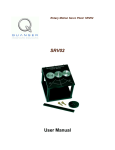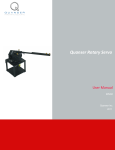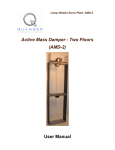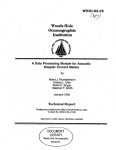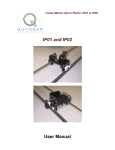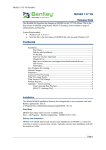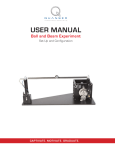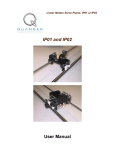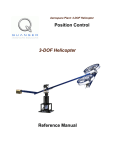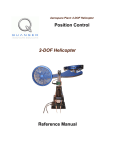Download SRV02 Ball and Beam User Manual
Transcript
Rotary Motion Servo Plant: SRV02 SRV02 Ball and Beam User Manual BB01 User Manual Table of Contents 1. PRESENTATION..........................................................................................................................................1 1.1. Description........................................................................................................................................1 1.2. Remote Sensor Option......................................................................................................................1 2. BALL AND BEAM COMPONENTS..................................................................................................................1 2.1. Component Nomenclature................................................................................................................2 2.2. Component Description....................................................................................................................3 2.2.1. Ball Position Sensor...............................................................................................................................3 2.2.2. Remote Sensor.......................................................................................................................................3 3. BALL AND BEAM SPECIFICATIONS...............................................................................................................3 4. SYSTEM SETUP..........................................................................................................................................5 4.1. Assembly..........................................................................................................................................5 4.2. Calibration........................................................................................................................................6 5. WIRING PROCEDURE.................................................................................................................................7 5.1. Cable Nomenclature.........................................................................................................................7 5.2. Typical Connections for UPM..........................................................................................................9 5.3. Typical Connections for Q3............................................................................................................12 6. TESTING AND TROUBLESHOOTING.............................................................................................................14 6.1. SRV02 Motor and Sensors.............................................................................................................14 6.2. Testing the Ball Position Sensor.....................................................................................................14 6.2.1. Testing.................................................................................................................................................14 6.2.2. Troubleshooting...................................................................................................................................15 Document Number 709 ♦ Revision 2.1 ♦ Page i BB01 User Manual 7. TECHNICAL SUPPORT...............................................................................................................................16 8. REFERENCES...........................................................................................................................................16 APPENDIX A: LINEAR TRANSDUCER SPECIFICATION SHEET............................................................................17 Document Number 709 ♦ Revision 2.1 ♦ Page ii BB01 User Manual 1. Presentation 1.1. Description The Quanser Ball and Beam module, pictured in Figure 1, consists a track on which the metal ball is free to roll. The track is fitted with a linear transducer to measure the position of the ball, i.e. it outputs a voltage signal proportional to the position of the ball. One side of the beam is attached to a lever arm that can be coupled to the load gear of the Quanser SRV02 unit. By controlling the position of the servo, the beam angle can be adjusted to balance the ball to a desired position. Figure 1: SRV02 Ball and Beam Module 1.2. Remote Sensor Option The SRV02 Ball and Beam module can also be accompanied by a remote ball sensor called the SS01 module. This permits a master-slave configuration where the ball command is generated by the SS01 instead of through a program. 2. Ball and Beam Components The Ball and Beam components are identified in Section 2.1. Some of the those components are then described in Section 2.2. Document Number 709 ♦ Revision 2.1 ♦ Page 1 BB01 User Manual 2.1. Component Nomenclature The components of the Ball and Beam module, i.e. the BB01 device, and the Remote Sensor system, i.e. SS01, are listed in Table 1 below and labeled in Figure 2 and Figure 3. ID # Component ID # Component 1 SRV02 8 Support base 2 Lever arm 9 Support arm screws 3 Coupling screw 10 Analog ball position sensor connector 4 Steel ball 11 Calibration base 5 BB01 Potentiometer sensor 12 SS01 Potentiometer sensor 6 BB01 Steel rod 13 SS01 Steel rod 7 Support arm 14 Analog remote sensor connector Table 1: BB01 components. Figure 2: Components of SRV02 BB01 module. Document Number 709 ♦ Revision 2.1 ♦ Page 2 BB01 User Manual Figure 3: Remote sensor components. 2.2. Component Description 2.2.1. Ball Position Sensor The track of the BB01 linear transducer module on which the metal ball is free to roll consists of a steel rod in parallel with a nickel-chromium wire-wound resistor forming the track. The resistive wire is the black strip that is stuck on the plastic which is fastened onto the metal frame. The position of the ball is obtained by measuring the voltage at the steel rod. When the ball rolls along the track, it acts as a wiper similar to a potentiometer resulting in the position of the ball. WARNING: Regular cleaning of the beam is recommended to ensure proper operation of the ball and beam experiment. Clean both the beam and the steel ball using rubbing alcohol. 2.2.2. Remote Sensor Similarly to the BB01, the SS01 has a wiper potentiometer sensor that detects the position of the ball. 3. Ball and Beam Specifications Table 2, below, lists and characterizes the main parameters associated with the BB01. See Figure 4 for an illustration of the Ball and Beam dimensions and the variables α, θ, and x that are associated with the system. Some of the parameters listed in Table 2 are used in the mathematical model. See Appendix A for more information on the BB01 linear transducer used to measure the ball position. Symbol Description Mass of ball and beam module Calibration base length Matlab Variable Value Unit Variati on 0.65 kg 50 cm Document Number 709 ♦ Revision 2.1 ♦ Page 3 BB01 User Manual Symbol Description Matlab Variable Calibration base depth Lbeam Beam length Distance between SRV02 output gear shaft and coupled joint Unit Variati on 22.5 cm L_beam Lever arm length rarm Value 42.55 cm 12.0 cm r_arm cm 2.54 Support arm length 16.0 cm rb Radius of ball. r_ball 1.27 cm mb Mass of ball. m_ball 0.064 kg Kbs Ball position sensor sensitivity K_BS -4.25 cm/V Vbias Ball position sensor bias power Vrange Ball position sensor measurement range ±12 V ±5 V Table 2: Ball and beam system specifications. Figure 4: Ball and beam schematic. Document Number 709 ♦ Revision 2.1 ♦ Page 4 BB01 User Manual 4. System Setup See Section 4.1 for instructions on how to to put the ball and beam plant together. Then, go through the calibration procedure in Section 4.2 before performing the laboratory. 4.1. Assembly Follow this procedure to setup the Ball and Beam module for experimental use: 1. Before beginning, ensure the SRV02 is setup in the high-gear configuration as detailed in Reference [2]. 2. Lay the calibration base, component #11 in Figure 2, flat on a table surface. 3. As pictured in Figure 5, place the SRV02 on its side such that the potentiometer gear fits into the cut-out section of the calibration base. Notice that the top gear of the SRV02 should be the small 24-tooth motor pinion gear. Figure 5: Setting up the SRV02-side of the BB01 plant. 4. Fasten the coupling screw, component #3, into the screw hole of the large 120-tooth load gear as depicted in Figure 5. 5. Place the support base of the ball and beam, component #8 into the cut-out section of the base, as pictured in Figure 2. Document Number 709 ♦ Revision 2.1 ♦ Page 5 BB01 User Manual 4.2. Calibration Once the BB01 is setup, follow this procedure to calibrate the beam: 1. Using an 9/64 Allen Key loosen the screws on the support arm, which are shown in Figure 2 by ID #9. 2. Place the steel ball on the beam such that it rests on the SRV02 side, as pictured in Figure 5. 3. As illustrated in Figure 6, below, manually rotate the servo load gear to the 0 degree position. That is, the coupling screw should be aligned with the 0 degree position, . Figure 6: BB01 Calibration: move SRV02 load gear to 0 degree position. 4. While holding the load gear at 0 degrees, vary the height of the support arm, component #7, such that the beam is horizontal. When the ball is centered on the beam it should lie motionless. Figure 7: Calibrated BB01: ball is balanced when centered on beam. Document Number 709 ♦ Revision 2.1 ♦ Page 6 BB01 User Manual 5. Once the beam is balanced, tighten the screws on the support arm, as shown in Figure 8 below, to finalize the calibration of the BB01 experiment. Figure 8: BB01 calibration: tighten support arm screws once beam is balanced. 5. Wiring Procedure The following is a listing of the hardware components used in this experiment: ● Power Amplifier: Quanser UPM 1503/2405, or equivalent. ● Data Acquisition Board: Quanser Q8, Q4, or equivalent. ● Rotary Servo Plant: Quanser SRV02, SRV02-T, SRV02- E, SRV02- EHR, or SRV02-ET. ● Ball and Beam Module: Quanser BB01 Module ● Remote Sensor (optional) Quanser SS01 Module See the references listed in Section 8 for more information on these components. The cables supplied with the BB01 are described in Section 5.1 and the procedure to connect the above components when using the UPM is given in Section 5.2 and when using the Q3 device is described in Section 5.3. 5.1. Cable Nomenclature Table 3, below, provides a description of the standard cables used in the wiring of the BB01 system. Document Number 709 ♦ Revision 2.1 ♦ Page 7 BB01 User Manual Cable Designation Description 5-pin-DIN to RCA This cable connects an analog output of the data acquisition terminal board to the power module for proper power amplification. 4-pin-DIN to 6-pin-DIN This cable connects the output of the power module, after amplification, to the desired DC motor on the servo. One end of this cable contains a resistor that sets the amplification gain. For example when carrying a label showing "5" at both ends, the cable has that particular amplification gain. Typically a load cable gain of “1” is used for most SRV02 experiments. 5-pin-stereoDIN to 5-pin-stereoDIN This cable carries the encoder signals between an encoder connector and the data acquisition board (to the encoder counter). Namely, these signals are: +5VDC power supply, ground, channel A, and channel B. 6-pin-miniDIN to 6-pin-miniDIN This cable carries analog signals (e.g., from joystick, plant sensor) to the UPM, where the signals can be either monitored and/or used by a controller. The cable also carries a ±12VDC line from the UPM in order to power a sensor and/or signal conditioning circuitry. Figure 9 "From Digital-To-Analog" Cable Figure 10 "To Load" Cable Of Gain 1 Figure 11 "Encoder" Cable Figure 12 "From Analog Sensors" Cable Document Number 709 ♦ Revision 2.1 ♦ Page 8 BB01 User Manual Cable Designation Description 5-pin-DIN to 4xRCA This cable carries the analog signals, unchanged, from the UPM to the Digital-ToAnalog input channels on the data acquisition terminal board. Figure 13 "To Analog-To-Digital" Cable Table 3 Cable Nomenclature 5.2. Typical Connections for UPM This section describes the typical connections used for to connect the BB01 plant to a data-acquisition board and a power amplifier. The connections are described in detail in the procedure below and summarized in Table 4. Follow these steps to connect the BB01 system: 1. It is assumed that the Quanser Q4 or Q8 board is already installed as discussed in the Reference [1]. If another data-acquisition device is being used, e.g. NI M-Series board, then go to its corresponding documentation and ensure it is properly installed. 2. Make sure everything is powered off before making any of these connections. This includes turning off your PC and the UPMs. 3. Connect the 5-pin-DIN to RCA cable from the Analog Output Channel #0 on the terminal board to the From D/A Connector on the Quanser Universal Power Module, or UPM. See cable #1 shown in Figure 14 and Figure 15. This carries the attenuated motor voltage control signal, Vm/Ka, where Ka is the UPM amplifier gain. 4. Connect the 4-pin-stereo-DIN to 6-pin-stereo-DIN that is labeled Gain 1 from To Load on the UPM to the Motor connector on the SRV02. See connection #2 shown in Figure 15 and Figure 16. This cable sets the gain of the amplifier to 1 and the connector on the UPM-side is black in colour. The cable transmits the amplified voltage that is applied to the SRV02 motor and is denoted Vm. 5. Connect the 5-pin-stereo-DIN to 5-pin-stereo-DIN cable from the Encoder connector on the SRV02 panel to Encoder Input # 0 on the terminal board, as depicted by connection #3 in Figure 14 and Figure 16. This carries the load shaft angle measurement and is denoted by the variable θl. CAUTION: Any encoder should be directly connected to the Quanser terminal board (or equivalent) using a standard 5-pin DIN cable. DO NOT connect the encoder cable to the UPM! Document Number 709 ♦ Revision 2.1 ♦ Page 9 BB01 User Manual 6. Connect the To A/D socket on the UPM to Analog Inputs #0-3 on the terminal board using the 5-pin-DIN to 4xRCA cable, as illustrated in Figure 14 and Figure 15 by connection #4. The RCA side of the cable is labeled with the channels. Note that the cable with label "1" is goes to Analog Input Channel #0. 7. Connect the S1 & S2 connector on the SRV02 to the S1 & S2 socket on the UPM using the 6pin-mini-DIN to 6-pin-mini-DIN cable. See connection #5 in Figure 15 and Figure 16. This carries the voltage signal from the potentiometer that is proportional to the load shaft angle and is represented by variable θl. 8. Connect the Ball Position Sensor connector on the BB01 to the S3 socket on the UPM using the 6-pin-mini-DIN to 6-pin-mini-DIN cable. This connection is labeled #6 in Figure 15 and Figure 17. It carries the measured ball position from the beam potentiometer and is denoted by the variable x. 9. If the SS01 remote sensor module (shown in Figure 3) will be used to command the ball position, then connect the Ball Position Sensor connector on the SS01 to the S4 socket on the UPM using the 6-pin-mini-DIN to 6-pin-mini-DIN cable. This connection is labeled #7 in Figure 15 and Figure 18. It carries the measured ball position from the remote beam potentiometer and is denoted by the variable xd. Figure 14: Connections on the Quanser Q8 Terminal Board. Figure 15: Connections on UPM. Document Number 709 ♦ Revision 2.1 ♦ Page 10 BB01 User Manual Figure 16: Connection on the SRV02.. Figure 17: Connections on BB01. Figure 18: Connections on SS01. Cable # From To 1 Terminal Board: Analog Output #0 UPM "From D/A" connector 2 UPM "To Load" connector SRV02 "Motor" connector 3 Terminal Board: Encoder Input #0 SRV02 "Encoder" connector 4 UPM "To A/D" connector 5 UPM "S1 & S2" connector Signal Control signal to the UPM Power leads to the SRV02 DC motor. Encoder load shaft angle measurement. Terminal Board: Carries the analog signals connected to the S1 to Analog Input #0 S1 & S2, S3, and S4 connectors on the UPM S2 to Analog Input #1 to the data-acquisition board. S3 to Analog Input #2 S4 to Analog Input #3 SRV02 “S1 & S2” connector Potentiometer load shaft angle measurement. Document Number 709 ♦ Revision 2.1 ♦ Page 11 BB01 User Manual Cable # From To Signal 6 UPM "S3" connector BB01 Ball Position Sensor connector BB01 ball position measurement. 7 UPM "S4" connector SS01 Ball Position Sensor connector SS01 ball position measurement. Table 4 BB01 system wiring summary when using a UPM. 5.3. Typical Connections for Q3 This section describes the typical connections used for to connect the BB01 plant to the Q3 dataacquisition / power amplifier board. The connections are described in detail in the procedure below and summarized in Table 5. Follow these steps to connect the BB01 system: 1. It is assumed that the Quanser Q3 board is already installed as discussed in the Reference [4]. 2. Make sure everything is powered off before making any of these connections. This includes turning off your PC and the Q3. 3. Connect the 4-pin-stereo-DIN to 6-pin-stereo-DIN from PWM Output #0 on the Q3 to the Motor connector on the SRV02. See cable #2 shown in Figure 16 and Figure 19. The cable transmits the controlled current that is applied to the SRV02 motor and is denoted Im. 4. If the SRV02 has the -E option then the encoder can be used to measure the load shaft angle. Connect the 5-pin-stereo-DIN to 5-pin-stereo-DIN cable from the Encoder connector on the SRV02 panel to Encoder Input # 0 on the Q3 board, as depicted by connection #3 in Figure 16, above. 5. Connect the Ball Position Sensor connector on the BB01 to the Sensor 1 socket on the Q3 Analog 2:1 Buffer box using the 6-pin-mini-DIN to 6-pin-mini-DIN cable. This connection is labeled #6 in Figure 17 and Figure 20. It carries the measured ball position from the beam potentiometer and is denoted by the variable x. Remark 1: Ensure the BB01 sensor is passed through the Q3 Analog 2:1 Buffer box. Otherwise the measured ball position signal will contain jitter and make the experiment difficult to control. Remark 2: Make sure the switch on the Q3 Analog 2:1 Buffer box is set to the downward “Secondary Sensor” position when using the BB01. 6. If the SS01 remote sensor module (shown in Figure 3) will be used to command the ball position, then connect the Ball Position Sensor connector on the SS01 to the Sensor 2 socket on the Q3 Analog 2:1 Buffer box socket using the 6-pin-mini-DIN to 6-pin-mini-DIN cable. This connection is labeled #7 in Figure 18 and Figure 20. It carries the measured ball position from the remote beam potentiometer and is denoted by the variable xd. 7. Connect the To Q3 connector on the Q3 Analog 2:1 Buffer box to the Analog Input connector on the Q3 using the 6-pin-mini-DIN to 6-pin-mini-DIN cable. This connection is labeled #8 in Figure 19 and Figure 20. It carries the conditioned measured ball position from the beam Document Number 709 ♦ Revision 2.1 ♦ Page 12 BB01 User Manual potentiometer and, if used, the remote beam potentiometer. Figure 19: Connections on the Q3 board from the Analog 2:1 Buffer box and the BB01. Figure 20: Connections on the Q3 Analog 2:1 Buffer box. Document Number 709 ♦ Revision 2.1 ♦ Page 13 BB01 User Manual Cable # From To 1 Q3: “Motors #0” connector SRV02 “Motor” connector 3 Q3: “Encoders #0” connector SRV02 "Encoder" connector 6 BB01 Ball Position Sensor connector Q3 Analog 2:1 Buffer: BB01 ball position measurement. “Sensor 1” connector 7 SS01 Ball Position Sensor connector Q3 Analog 2:1 Buffer: SS01 ball position measurement. “Sensor 2” connector 8 Q3 Analog 2:1 Buffer: “To Q3” connector Q3: “Analog Input” connector Signal PWM signal to the DC motor. Encoder load shaft angle measurement. Conditioned ball measurement on the BB01 and SS01. Table 5 BB01 system wiring summary when using the Q3. 6. Testing and Troubleshooting This section describes some functional tests to determine if your Ball and Beam system is operating normally. It is assumed that the SRV02 is connected as described in the Section 5.2, above. To carry out these tests, it is preferable if the user can use a software such as Quarc or LabVIEW to read sensor measurements and feed voltages to the motor. See Reference [3] to learn how to interface the SRV02 with Quarc. Alternatively, these tests can be performed with a signal generator and an oscilloscope. 6.1. SRV02 Motor and Sensors See Reference [2] for information on testing and troubleshooting the SRV02 separately. 6.2. Testing the Ball Position Sensor 6.2.1. Testing Test the ball position sensor from the BB01 or the SS01 with the following procedure: 1. Using a program such as Quarc, measure the analog input channel #2 to test the BB01 sensor or analog input channel #3 to test the SS01 sensor. 2. A typical signal response of the ball position sensor is illustrated in Figure 21. For the BB01, the ball position sensor should output a voltage of about 4.5 V when it is closest to the SRV02. As the ball is rolled away from the SRV02 the measured voltage signal should be decreasing down Document Number 709 ♦ Revision 2.1 ♦ Page 14 BB01 User Manual to approximately -4.5 V when the ball reaches the other end of the beam. Sometimes when the ball is sitting at the very end of the beam it may not be in contact with the sensor. In this case the reading will initially be 0 V but when the ball begins moving the sensor signal will jump up to about 4.5 V and then begin decreasing. Besides the ends of the beam, the signal should have no discontinuities and little noise. Similarly for the SS01 sensor, the voltage signal should decreasing from approximately 4.5 V to -4.5 V as the ball travels towards the end of the beam with the analog connector. Figure 21: Typical voltage signal from BB01 ball position sensor. 6.2.2. Troubleshooting Follow the steps below if the potentiometer is not measuring correctly: ● Verify that the power amplifier is functional. For example when using the Quanser UPM device, is the red LED in the top-left corner lit? Recall that the analog sensor signal goes through the UPM before going to the data-acquisition device. Therefore the UPM needs to be turned on to read the potentiometer. ● Check that the data-acquisition board is functional, e.g. the red LED on the Quanser Q4/Q8 terminal board should be bright red. If not then the DAC board fuse may be burnt and need replacement. ● Measure the voltage across the potentiometer. Ensure the potentiometer is powered with a ±12V at the 6-pin-mini DIN connector on the BB01, component #10 in shown in Figure 2, or on the SS01, component # 14 in Figure 3. The two bottom pins of the DIN connector are GND pins and the leftmost pin, i.e. where the green cable is connected to, outputs the voltage of the ball. Using a voltmeter, connect one probe to the middle-left pin and the other to the bottom GND pins. The voltage should vary between about ±4.5 volts as the ball position is changed. If the voltage does not change when you rotate the potentiometer shaft, your potentiometer needs to be Document Number 709 ♦ Revision 2.1 ♦ Page 15 BB01 User Manual replaced. Please see Section 7 for information on contacting Quanser for technical support. 7. Technical Support To obtain support from Quanser, go to http://www.quanser.com/ and click on the Tech Support link. Fill in the form with all the requested software and hardware information as well as a description of the problem encountered. Also, make sure your e-mail address and telephone number are included. Submit the form and a technical support person will contact you. Note: Depending on the situation, a support contract may be required to obtain technical support. 8. References [1] Quanser. Q4/Q8 User Manual. [2] Quanser. SRV02 User Manual. [3] Quanser. Rotary Experiment #0: SRV02 Quarc Integration. [4] Quanser. Q3 Manual. Document Number 709 ♦ Revision 2.1 ♦ Page 16 BB01 User Manual Appendix A: Linear Transducer Specification Sheet Document Number 709 ♦ Revision 2.1 ♦ Page 17





















